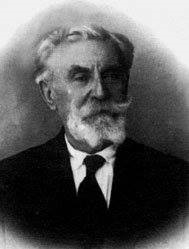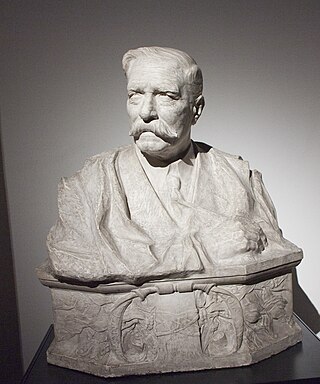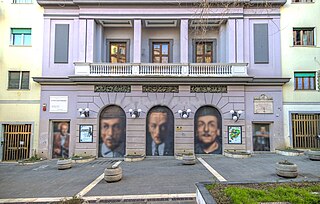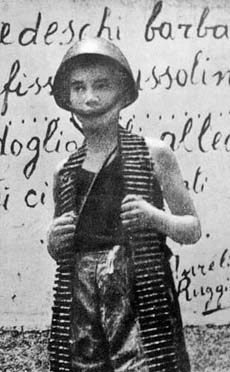
Filippo Antonio Cifariello (3 July 1864, Molfetta - 5 April 1936, Naples) was an Italian sculptor; primarily of small figures and busts.

Filippo Antonio Cifariello (3 July 1864, Molfetta - 5 April 1936, Naples) was an Italian sculptor; primarily of small figures and busts.
He was the first of five children born to Ferdinando Cifariello, a singer from Bari, and his wife, Giovanna née Rutigliano. While he was still a boy, his family moved to Naples where his father attempted, unsuccessfully, to promote his career and they fell into poverty. It was there, in an effort to support his family, that he began to display his artistic abilities. Eventually, he was able to enter the Accademia di Belle Arti di Napoli, where he studied with the painter, Gioacchino Toma. His interest in sculpture led him to spend some time in Rome and Munich. [1]
![Primi Palpiti
(First [Heart]Throbs),
one of his earliest works Filippo cifariello, primi palpiti, 1883.JPG](http://upload.wikimedia.org/wikipedia/commons/thumb/a/ac/Filippo_cifariello%2C_primi_palpiti%2C_1883.JPG/185px-Filippo_cifariello%2C_primi_palpiti%2C_1883.JPG)
He was exhibiting regularly by 1881; receiving an award in Naples in 1883. His first true success came at the Exposition Universelle (1889), in Paris. After that, he lived in Rome. In 1899, he began exhibiting at the Venice Biennale. [1] He was later named a Commander in the Order of the Crown of Italy. [2]
In 1894, he married the French singer Maria de Browne; known by her stage name, Blanche de Mercy. The letters of admiration she received from her fans drove him to fits of jealousy. At one point, he accepted a position as Director of a factory that made art objects, in Passau, Germany, to take her away from Rome. She felt isolated there, and spent some time on an unsuccessful tour in the United States. [3] They eventually returned to Rome. In 1905, he met her lawyer, who he suspected of being her lover, come out of their home. Following a serious quarrel, he bought a gun and, on August 10, killed her; shooting her five times with a revolver. He claimed that she had threatened him with a gun first. [4]
His trial generated much publicity, with a strenuous defense by the lawyer, Gaetano Manfredi (1849-1912), in the assize court of Campobasso. After two years, he was acquitted for lack of imputability ; roughly equivalent to temporary insanity. Upon being freed, he returned to Naples, where he was able to resume his career. [1]
![Bust of Enrico Caruso at the Museo Enrico Caruso [it] in Lastra a Signa Filippo cifariello, busto di enrico caruso, 1899 ca. (gesso=).JPG](http://upload.wikimedia.org/wikipedia/commons/thumb/b/b3/Filippo_cifariello%2C_busto_di_enrico_caruso%2C_1899_ca._%28gesso%3D%29.JPG/200px-Filippo_cifariello%2C_busto_di_enrico_caruso%2C_1899_ca._%28gesso%3D%29.JPG)
His misfortunes continued in 1914 when his second wife, twenty-two-year-old Evelina Fabbri, whom he had married only three weeks before, died of severe burns caused by a spill from an alcohol stove. She survived long enough to clear him of any responsibility. In 1928, he married a third time, to Anna Marzell from Germany. They had two children, including the famous actor, Antonio Cifariello. He suffered from serious bouts of depression, however, and committed suicide in his studio, by shooting himself in the head, at the age of seventy-one. [4]
In 1931, he wrote an autobiography: Tre vite in una (Three Lives in One), which was briefly popular. In his final years, he focused on portrait busts.
The Salimbeni Prize is awarded by the Fondazione Salimbeni per le Arti Figurative of San Severino Marche to honour excellence in the writing of art history on an Italian subject. The Premio Salimbeni was established in 1983.

Eduardo De Filippo, also known simply as Eduardo, was an Italian actor, director, screenwriter and playwright, best known for his Neapolitan works Filumena Marturano and Napoli Milionaria. Considered one of the most important Italian artists of the 20th century, De Filippo was the author of many theatrical dramas staged and directed by himself first and later awarded and played outside Italy. For his artistic merits and contributions to Italian culture, he was named senatore a vita by the President of the Italian Republic Sandro Pertini.

Renato Terra had a career working in film as an actor, and has appeared in over 80 movies. In 1977 he retired to become a poet.

Giovanni Battista Caracciolo (1578–1635) was an Italian artist and important Neapolitan follower of Caravaggio. He was a member of the murderous Cabal of Naples, with Belisario Corenzio and Giambattista Caracciolo, who were rumoured to have poisoned and disappeared their competition for painting contracts.

Guglielmo della Porta was an Italian architect and sculptor of the late Renaissance or Mannerist period.
Mariangiola Criscuolo was an Italian painter of the Renaissance period, active mainly in her native city of Naples. She is known for portraiture and history painting, and excelled in painting altarpieces. She was also involved in the foundation of one of the first female-organized schools of art during the sixteenth century.

Mauro Del Giudice was an Italian magistrate, jurist and writer.

Eduardo Dalbono was an Italian painter born in Naples.

Francesco Lojacono or Lo Jacono (1838–1915) was an Italian painter, mainly of landscapes and seascapes, and mainly active in his native Palermo, Sicily.

Attilio Pratella was an Italian painter, noted for his landscapes and realistic scenes of Neapolitan life.

Teatro San Ferdinando is a theatre in Naples, Italy. It is named after King Ferdinand I of Naples. Located near Ponte Nuovo, it is to the southeast of the Teatro Totò in the western part of the neighborhood of Arenaccia. Built in the late eighteenth century, the seats are arranged in four box tiers, and the pit. It is most associated with Eduardo De Filippo and the productions of the 1950s under his direction. Closed in the 1980s and reopened in 2007, the San Fernando is managed by the Teatro Stabile of Naples.

Giuseppe Amisani was an Italian portrait painter of the Belle Époque.

Antonino or Antonio Leto was an Italian painter, painting mainly genre/landscape subjects in an impressionistic style.
Filippo Andrea Francesco Coletti was an Italian baritone associated with Giuseppe Verdi. Coletti created two Verdi roles: Gusmano in Alzira and Francesco in I masnadieri. Verdi revised the role of Germont in La traviata for Coletti, whose interpretation re-defined the role as it is known today. Coletti was, with Antonio Tamburini (1800–1876) and Giorgio Ronconi (1810–1890), one of the three leading baritones of 19th century Italy, an early model of a 'Verdi baritone'.
Olga Napoli was an Italian painter, considered one of the most complex artists of the Southern Italian Post-World War II cultural landscape.

Filippo Illuminato was an Italian partisan who died attacking Nazi German troops during the Four days of Naples in World War II. He was posthumously awarded the Gold Medal of Military Valour, Italy's highest award for gallantry.

Carmen Moscariello is an Italian poet.

Antonio Bulifon (1649-1707) was a French printer working in Naples. As a publisher Bulifon was "fundamentally important for the diffusion of women's poetry" in Italy.

The history of cinema in Naples begins at the end of the 19th century and over time it has recorded cinematographic works, production houses and notable filmmakers. Over the decades, the Neapolitan capital has also been used as a film set for many works, over 600 according to the Internet Movie Database, the first of which would be Panorama of Naples Harbor from 1901.
Tommaso Costo was an Italian Renaissance humanist and writer.